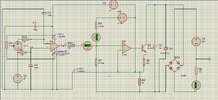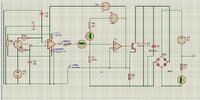kemaltekbas
New Member
Hi all,
I’m new to circuit design and working on a 4-20mA 2-wire loop-powered system to convert a 0-50mV sensor output using the XTR116 (simulated based on the datasheet since I couldn’t find a library). I’m stuck on a couple of issues and need help:
Thanks for any help!
I’m new to circuit design and working on a 4-20mA 2-wire loop-powered system to convert a 0-50mV sensor output using the XTR116 (simulated based on the datasheet since I couldn’t find a library). I’m stuck on a couple of issues and need help:
- My sensor has a common mode voltage (50% of input). I added a voltage source at the AD623 input to simulate this. For 1-50mV inputs, I get 4.32-20mA output, which is great. But the AD623 output has an offset from the REF pin (tied to my simulated IRET). Oddly, the current through my 25kΩ resistors is always correct (e.g., 160µA at 50mV). Why is this happening?
- At 0mV input, the AD623 output doesn’t go to 0V due to the REF pin offset, so I get 7mA instead of 4mA. How can I fix this to ensure 0mV gives 4mA?
Thanks for any help!


